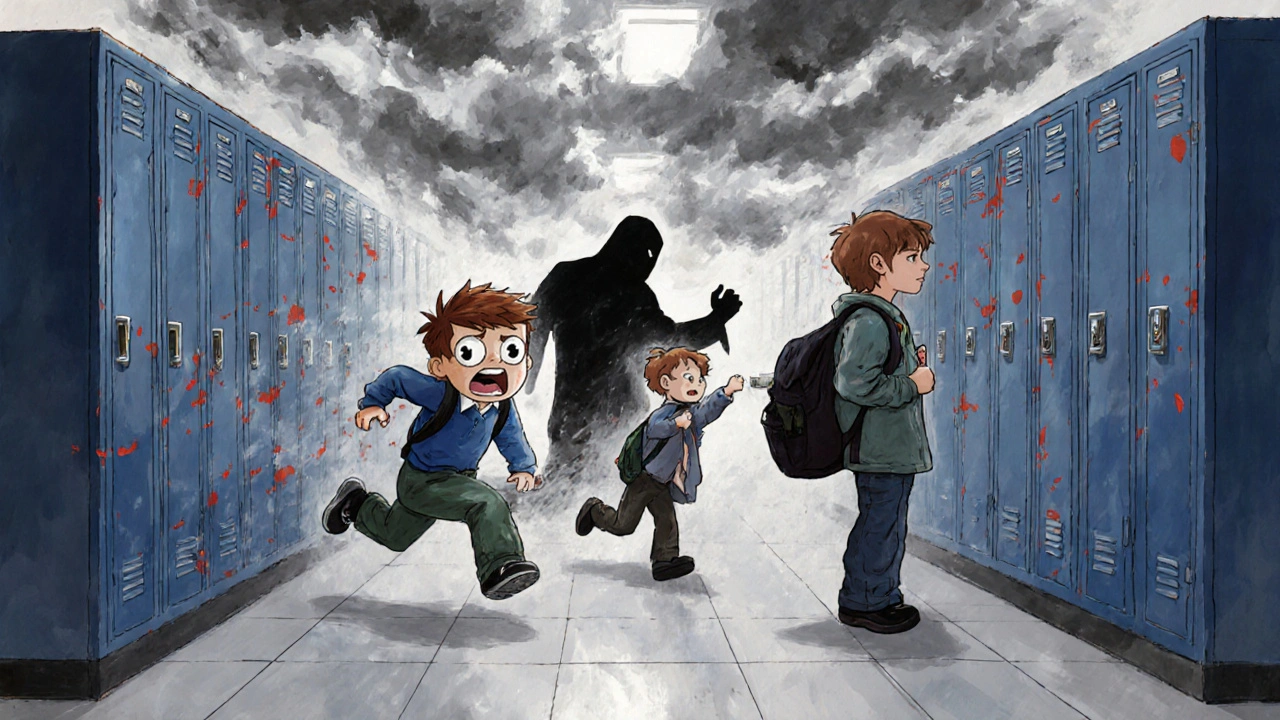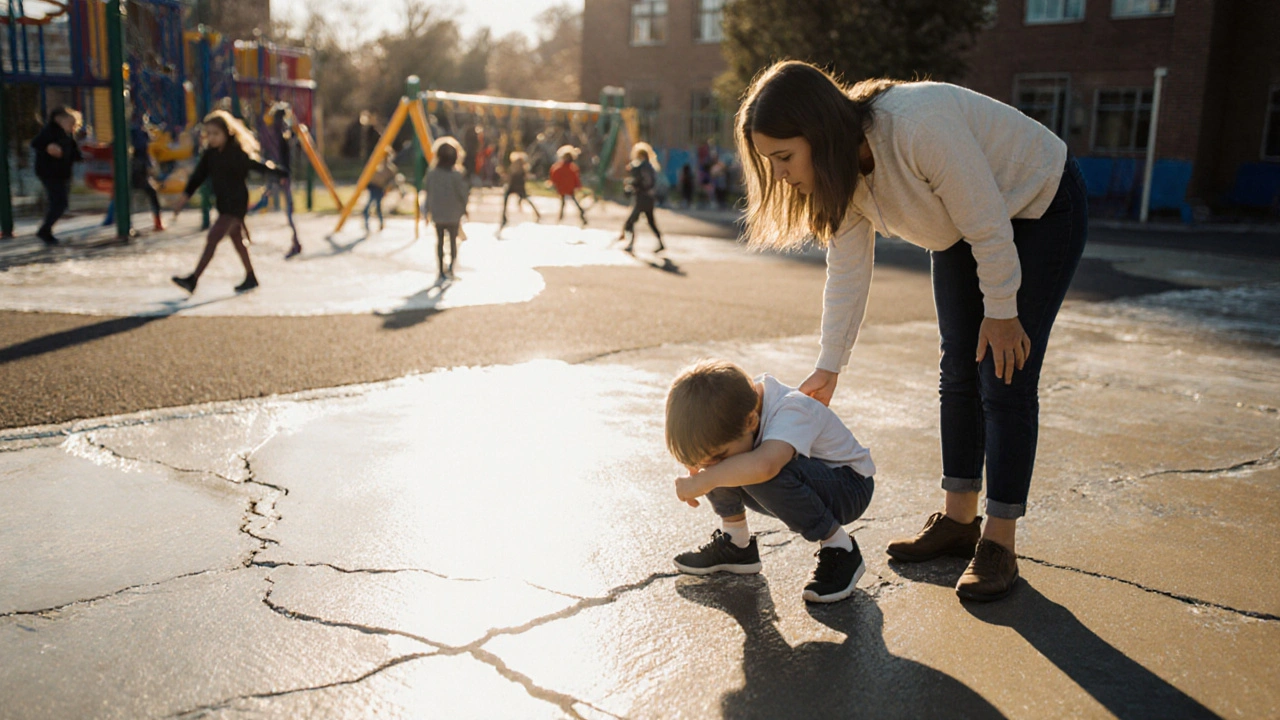When a child’s actions start to clash with classmates or family routines, it can feel like you’re walking on thin ice. The mix of behavior disorders a group of mental‑health conditions that shape how kids think, feel, and act and bullying creates a perfect storm for stress at home and school. This guide cuts through the jargon and gives you clear steps to spot problems early, talk with your child, and partner with professionals before the situation spirals.
Key Takeaways
- Behavior disorders often amplify bullying risk, but early intervention can change the trajectory.
- Watch for specific warning signs - impulsivity, frequent conflicts, or sudden withdrawal.
- Effective strategies blend consistent parenting, school collaboration, and, when needed, professional treatment.
- Anti‑bullying programs that teach empathy and conflict‑resolution work best when paired with home‑based support.
- You are not alone; a network of counselors, pediatricians, and teachers can help you navigate the path.
What Exactly Are Behavior Disorders?
Broadly, behavior disorders include conditions that cause persistent patterns of disruptive or harmful actions. The most common types affecting school‑age children are:
- Attention‑Deficit/Hyperactivity Disorder (ADHD) characterized by inattention, hyperactivity, and impulsivity
- Oppositional Defiant Disorder (ODD) marked by a chronic pattern of angry, irritable mood and defiant behavior toward authority
- Conduct Disorder involves aggression toward people or animals, property destruction, and serious rule violations
Each of these conditions can exist alone or overlap, and they often co‑occur with anxiety or depression, further complicating a child’s social experience.
Bullying: More Than a Schoolyard Issue
Bullying is defined as bullying repeated aggressive behavior that involves an imbalance of power. It can be physical, verbal, relational, or digital. When a child already struggles with self‑control or emotional regulation because of a behavior disorder, the likelihood of both being bullied and bullying others spikes dramatically.
Recent data from the 2024 National Center for Education Statistics shows that 23% of students with ADHD report being bullied, compared with 13% of peers without a diagnosis. The reverse is also true: children with ODD or Conduct Disorder are twice as likely to act as bullies.

Early Warning Signs Every Parent Should Spot
Detecting the intersection early can prevent a cascade of problems. Keep an eye on these red flags:
- Frequent fights or teasing incidents at school or in the neighborhood.
- Sudden changes in mood-e.g., an extra‑quiet child becoming hostile.
- Escalating use of harsh language or threats, especially online.
- Complaints of headaches, stomachaches, or other psychosomatic symptoms that often accompany stress.
- Teacher reports of “disruptive” behavior that seem out of character for your child’s usual temperament.
If two or more of these appear over several weeks, it’s time to act.
Practical Parenting Strategies
Combining empathy with clear expectations works wonders. Here are actionable steps you can start today:
- Set consistent rules. Write them down, display them on the fridge, and review them weekly.
- Teach emotional vocabulary. Use feeling cards or apps that label emotions; practice naming feelings during calm moments.
- Model respectful conflict resolution. Narrate your own approach when disagreements arise - “I feel frustrated, so I’ll take a deep breath before I respond.”
- Use positive reinforcement. Praise specific behaviors (“You waited your turn before speaking”) rather than vague compliments.
- Monitor digital activity. Install parental controls, but also discuss online etiquette and the impact of cyber‑bullying.
- Partner with the school. Request a meeting with teachers, counselors, and the school’s anti‑bullying coordinator to create a joint action plan.
Consistency is key; children with behavior disorders thrive on predictable structures.
When Professional Help Is Needed
If home‑based strategies aren’t enough, professional support can address the underlying neuro‑developmental or emotional factors. Below is a quick comparison of the three main behavior disorders, their typical treatments, and how they relate to bullying risk.
| Disorder | Core Symptoms | First‑line Treatment | Bullying Risk |
|---|---|---|---|
| ADHD | Inattention, hyperactivity, impulsivity | Stimulant medication + behavior therapy | Higher likelihood of being targeted |
| ODD | Frequent temper loss, defiant behavior | Parent‑child interaction therapy, CBT | Both bully and victim roles common |
| Conduct Disorder | Aggression, property destruction, rule violations | Intensive multi‑system therapy, possible medication for co‑occurring ADHD | High likelihood of being the bully |
Therapists often incorporate social‑skills training that directly addresses bullying dynamics-teaching kids how to read social cues, negotiate conflicts, and stand up for themselves without aggression.

School’s Role and Anti‑Bullying Programs
Most districts now run anti‑bullying programs structured initiatives that teach empathy, safe reporting, and peer‑mediated conflict resolution. The most effective ones have three core components:
- Education. Classroom lessons on empathy, digital citizenship, and by‑stander intervention.
- Policy. Clear rules with consistent consequences, plus a confidential reporting system.
- Support. Access to school counselors trained in behavior‑disorder interventions.
When a parent alerts the school about a possible behavior‑disorder‑related bullying issue, the staff can trigger a “response protocol” that includes observation, a meeting with the child’s teacher, and, if needed, a referral to a mental‑health professional.
Putting It All Together: A Simple Action Plan
- Observe and note specific incidents - date, what happened, who was involved.
- Talk to your child in a calm setting; use open‑ended questions (“Can you tell me what happened?”).
- Reach out to the school’s counselor with your notes; request a joint meeting.
- Schedule a pediatric or child‑psychiatry evaluation if symptoms persist beyond twomonths.
- Implement at‑home strategies consistently; track progress weekly.
- Re‑assess every6weeks and adjust the plan with professionals.
Following these steps creates a safety net that catches problems early, reduces the chance of chronic bullying, and supports healthier emotional growth for your child.
Remember, you don't have to navigate this alone. Schools, clinicians, and community groups are ready to partner with you. With the right mix of observation, communication, and professional help, you can turn a challenging situation into an opportunity for lasting change.
Frequently Asked Questions
How can I tell if my child’s aggression is due to a behavior disorder or just a phase?
Look for persistence and intensity. If aggressive actions are frequent, occur across multiple settings (home, school, peers), and are accompanied by other symptoms such as inattention or defiance, it’s worth seeking a professional evaluation. A brief screening by a pediatrician can differentiate a developmental disorder from a temporary reaction to stress.
Can medication help reduce bullying behavior?
Medication, especially stimulants for ADHD, can improve impulse control and attention, which often reduces both victimization and perpetration. Medication alone isn’t enough; combine it with behavioral therapy and school‑based support for lasting results.
What should I do if my child is being cyber‑bullied?
Document screenshots, note timestamps, and report the content to the platform. Talk to the school’s IT coordinator and ask for a formal incident report. At home, reinforce digital etiquette and consider temporary monitoring tools while teaching the child how to respond safely.
Are there free resources for families dealing with behavior disorders?
Many community health centers offer sliding‑scale counseling. The National Institute of Mental Health provides downloadable guides on ADHD and ODD. Public schools are also required to provide an Individualized Education Program (IEP) or 504 plan at no cost if a disorder impacts learning.
How can I support my child’s self‑esteem while addressing bullying?
Focus on strengths unrelated to the bullying context-art, music, sports, or academic achievements. Celebrate small victories, encourage participation in clubs, and model self‑compassion. A therapist can teach specific confidence‑building exercises tailored to your child’s needs.
By staying vigilant, communicating openly, and leveraging professional resources, you can guide your child out of the bullying cycle and toward a healthier, happier future.
behavior disorders affect millions of families, but with the right knowledge and support, parents can turn challenges into growth opportunities.


Abhimanyu Singh Rathore
October 7, 2025 AT 13:26Wow, what a thorough guide, parents! The mix of behavior disorders and bullying can really feel like walking on thin ice, and you’ve laid out the steps like a lifeboat, clear and steady, ready to rescue families in stormy seas.
Stephen Lewis
October 15, 2025 AT 19:36In my professional opinion, the systematic approach outlined herein aligns with evidence‑based interventions; it is commendable for its comprehensive nature and clarity.
janvi patel
October 24, 2025 AT 01:46Honestly, I think the guide overcomplicates simple parenting.
Lynn Kline
November 1, 2025 AT 07:56Love the vibrant tone-using feeling cards and empathy drills is like giving kids a palette of emotions, they can paint healthier interactions!
Rin Jan
November 9, 2025 AT 14:06This guide really hit the spot for anyone dealing with the tangled web of behavior disorders and bullying.
It starts by reminding us that early signs are not just random hiccups but can be warning lights.
The list of red flags, from frequent fights to sudden silence, is spot on and easy to scan.
I appreciate the emphasis on consistent rules written on the fridge because kids thrive on predictability.
Teaching emotional vocabulary through cards is a clever trick that many parents overlook.
Modeling respectful conflict resolution by narrating your own feelings sets a powerful example.
Positive reinforcement, when specific, turns good behavior into a habit rather than a vague hope.
Monitoring digital activity while keeping the conversation open about online etiquette balances safety and trust.
Partnering with the school, as the guide suggests, creates a united front that can catch issues before they spiral.
The table comparing ADHD, ODD, and Conduct Disorder helps demystify the differences in a glance.
Knowing that medication can aid impulse control but is not a silver bullet reinforces the need for therapy.
The anti‑bullying program components-education, policy, support-are laid out clearly and make sense.
Action steps like observing incidents, noting dates, and holding calm talks with your child give a roadmap that feels doable.
The reminder that you are not alone, and that counselors, pediatricians, and teachers are there, is reassuring.
Overall, the guide turns a daunting situation into a manageable plan, and that empowerment is priceless.
Jessica Taranto
November 17, 2025 AT 20:16Great resource. The FAQ section answered many of my lingering doubts. I will share this with the support group.
akash chaudhary
November 26, 2025 AT 02:26While the article covers a lot, it fails to mention that behavior disorders often stem from underlying trauma, a fact that should not be ignored, and the suggested strategies sometimes sound like generic parenting advice, which is insufficient for severe cases.
Adele Joablife
December 4, 2025 AT 08:36The guide is comprehensive, yet I think it could benefit from more real‑world case studies to illustrate the application of the strategies in diverse family dynamics.